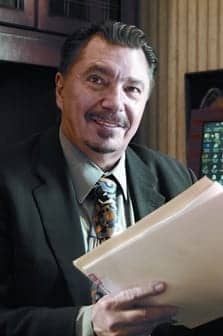Pandemic-related stress has meant more patients need help with temporomandibular joint disorders at one dental sleep medicine center.
By Richard E. Klein, DDS
In the April 2020 issue of Sleep Review, Sree Roy wrote, “One of the best analogies I’ve seen described sleep as a ‘shield’ against stress.” She quoted a University of Queensland professor who said, “When you don’t get enough sleep the shield cracks and you are more susceptible to stress.”
That certainly is evident in today’s patients. The unexpected, volatile, and life-changing COVID-19 pandemic has caused multiple problems, including ramifications and causality of a variety of medical problems that had been controlled or under the radar previously. In my dental sleep medicine practice, I have seen this in relation to obstructive sleep apnea (OSA) and temporomandibular disorder (TMD).
OSA and TMD are two diagnoses that are intimately related to cranial anatomy. Multiple peer-reviewed articles indicate that a person with a retrognathic mandible is significantly more prone to both OSA and TMD. Adherent CPAP use that eliminates sleep-disordered breathing will not necessarily eliminate or reduce sleep bruxism.1
Obviously, stress has ramifications for sleep. Stress inhibits restful sleep (for example, it can add to difficulty falling or staying asleep), and stress inherently may also cause muscle tightening, especially in the cervical and facial muscles. When people are anxious, they will reflexively stiffen the neck and jaw muscles. Anxiety not only denigrates a normal, healthy sleep, it is also a precursor or instigator of multiple medical problems including TMD. When COVID-19 stress affects our patients, they may not understand these new or returned impairments—causing their stress levels to further increase.
If the masticatory muscles are painful, a patient might not want to eat—since chewing and swallowing is uncomfortable. Since a symptom of COVID-19 is loss of appetite, they may wrongly think they have the potentially fatal virus, a worry that creates a vicious cycle with more fear and more loss of appetite. By explaining to a patient that the anterior digastric muscle shortens, tightens, and torques on the hyoid bone as it is reacting to TMD, which makes it difficult to swallow, this may alleviate their fear with understanding and help them begin to eat normally again.
Pain of the head and face is measurably different from pain in the rest of the body, both subjectively and in the brain. Studies have found that people rate head and facial pain as more severe, emotionally draining, and scary than pain elsewhere. Pain in the face leads to greater activation of the amygdala, a key fear center of the brain. What’s more, the lateral parabrachial nucleus is an important node along a neural circuit that conveys pain signals between the spinal cord/brainstem and emotional centers in the brain. The pathway is thought to encode the emotional aspects of pain, such as suffering and fear. This suggests the system is evolutionarily wired to respond to head and face pain more quickly and intensely.2
There are multiple studies about the effects of chronic pain on the brain and the potential slow amelioration of those effects as the pain is appropriately treated. Pain from chronic TMD not only similarly activates the effects of pain from other areas of the body but can also concomitantly alter brain activity—due to multiple signs and symptoms of TMD that are painful physically, emotionally, and cognitively. It is almost a guarantee that pain from the many areas of the face, jaw, neck, eyes, and ears will exacerbate stress and healthy sleep cycles.

What’s more, when patients with chronic pain become stressed, they can’t sleep normally, and cognition can be affected by the mechanisms involved in stress and create changes in brain structure and function. Chronic stress is well known to trigger a cascade of events impacting sympathetic nervous system activity, neuroendocrine response, and possibly immune system activity. The long-term impact of stress related to patients with chronic pain may manifest itself in brain behavior responses similar to those seen in the trauma population.
Chronic pain may be felt and yet scientifically remain unexplained, making it a personal experience that is difficult to measure and understand. Some individuals can cope with high degrees of pain, while others are more negatively affected. The fear of the unknown increases stress in patients and its multiple emotional, cognitive, and physical sequelae.
Dentists are aware of negative emotional and cognitive changes in our patients, which improve as the multiple TMD symptoms ameliorate and disappear with treatment. Some of the often-seen symptoms of TMD include:
- earache (otalgia): as a trigger point referral from the zygomatic fibers of the masseter;3
- dizziness: as the tensor veli palatini muscle torques on the eustachian tube;4
- ear congestion: buzzing as the anterior malleolar ligament positionally alters the malleus when pulled within the petrotympanic fissure when the temporomandibular meniscus moves (partial or complete blockage of the eustachian tube can relate to ear fullness);
- subjective hearing loss: caused by the tensor tympani muscle pulling on the eardrum;
- intermittent blurred vision: caused by all six extraocular muscles tightening simultaneously;5
- retro-orbital eye pain: caused by the sphenomandibularis muscle tightening and pulling on the sphenoid bone;6
- and eye tearing (lacrimation): when the orbicularis muscle contracts, it shortens the canaliculi of the nasolacrimal duct system causing tears.7
[RELATED: Why My Dental Practice Treats Only TMD and Sleep]
The International Association for the Study of Pain has published a definition of pain that reflects what has been learned about pain in the last four centuries, and primarily in the past half century: Pain is “an unpleasant sensory and emotional experience associated with actual or potential tissue damage, or described in terms of such damage.” From this definition, we can conceptualize that pain is a perception, in the same way that eye and ear sensations due to muscle pain and foreshortening are. Its significance is determined by the cerebral cortex in the same fashion as that of other activities there. It is activated and transmitted by sensitivity to chemical changes in the tissues. This perception is real, whether harm has occurred or is occurring, and other research has investigated and documented that facial pain creates a more severe proprioception of the pain.
OSA and TMD are both aggravated immensely during this pandemic, and sleep clinicians should be prepared to manage an influx of patients with these symptoms. But one day, the stress from COVID-19 will disappear and we will resume with our lives.
Richard E. Klein, DDS, is founder and president of Michigan Head & Neck Institute in Warren, Mich.
Image: ID 34490148 © Vitaliy Smolygin | Dreamstime.com
References
- Balasubramaniam R, Klasser GD, Cistulli PA, Lavigne GJ. The link between sleep bruxism, sleep disordered breathing and temporomandibular disorders: an evidence-based review. JDSM. 2014;1(1):27–37.
- Rodriguez E, Sakurai K, Jennie Xu J, et al. A craniofacial-specific monosynaptic circuit enables heightened affective pain. Nat Neurosci. 2017 Dec;20(12)1734-43.
- Keersmaekers K, De Boever JA, Van Den Berghe L. Otalgia in patients with temporomandibular joint disorders. J Prosthet Dent. 1996;75(1):72–6.
- Chole RA, Parker WS. Tinnitus and vertigo in patients with temporomandibular disorder. Arch Otolaryngol Head Neck Surg. 1992;118(8):817–21.
- Peng Y. Temporomandibular joint disorders as a cause of aural fullness. Clin Exp Otorhinolaryngol. 2017 Sep;10(3):236-40.
- Ernest EA III. Sphenomandibularis muscle and retro-orbital headache. Practical Pain Management. 28 Dec 2011;8(9).
- Molina OF, Dos Santos J Jr, Nelson SJ, Nowlin T. Profile of TMD and bruxer compared to TMD and nonbruxer patients regarding chief complaint, previous consultations, modes of therapy, and chronicity. Cranio. 2000;18:3, 205-19.





